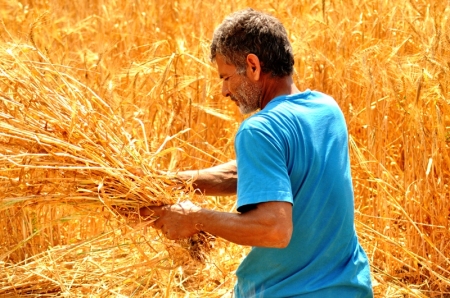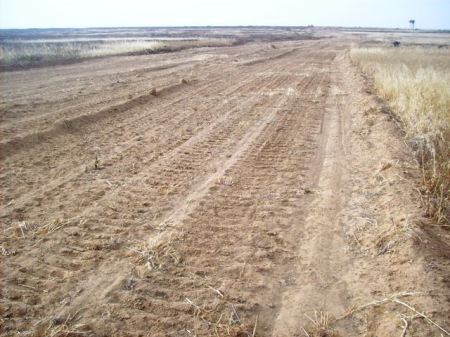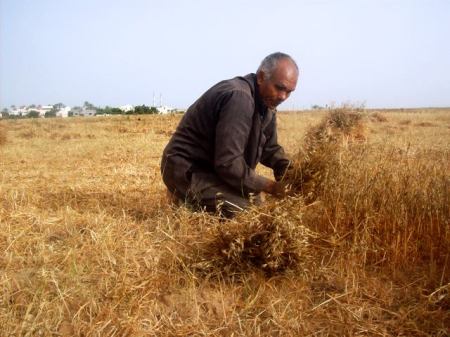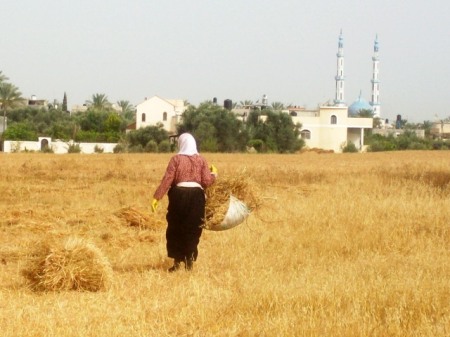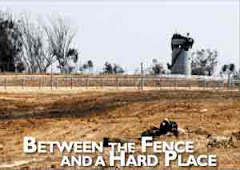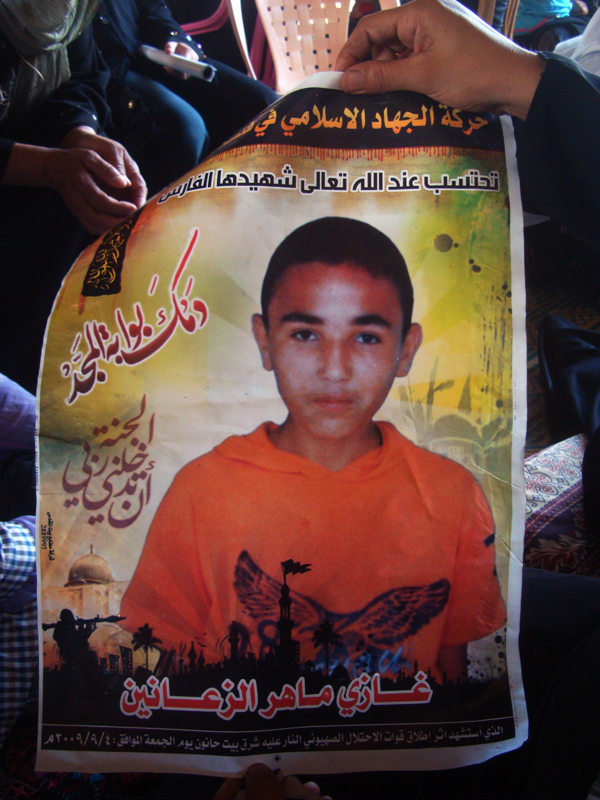May 7, 2010
 |
| Ahmed Deeb after he was fatally shot by an Israeli soldier at a protest in the occupied Gaza Strip. (Hatem Omar/MaanImages) |
The Electronic Intifada
“There was a single shot without any warning, and a young man was carried away,” Adie Mormech explained.
Mormech, currently in Gaza, is a British activist with the International Solidarity Movement (ISM). He was an eyewitness at the 28 April demonstration at Nahal Oz, east of Gaza City,
when Ahmed Deeb was fatally shot by an Israeli soldier.
“I could see the bullet had blown apart a large section of the top his leg, with a large amount of blood. He was carried about 100 meters with blood pouring down his leg before a waiting ambulance drove him away.”
Hours after being shot in the femoral artery by an Israeli soldier, Deeb died of blood loss.
Deeb, 21, was the ninth protester shot by Israeli soldiers during nonviolent demonstrations in the border regions against the Israeli-imposed “buffer zone.” With the Israeli threat to shoot with live ammunition at anyone within 300 meters of the border, this buffer zone violently restricts Palestinians from accessing land in the border areas.
Prior to Deeb’s killing, in the space of less than one month, eight unarmed protesters have been shot by Israeli soldiers, including a young Palestinian woman and a female ISM activist. Although aware of the likelihood that Israeli soldiers will open fire on the crowd, demonstrators like Deeb participate to protest the siege and theft of their land.
According to the Palestinian Centre for Human Rights (PCHR), the buffer zone was established during the Oslo accords, taking 50 meters of land on the Palestinian side only and all along the border. In 2000, this was unilaterally expanded by the Israelis to 150 meters on the Palestinian side only, expanded again to 300 meters with the threat to shoot anyone found within that distance in January 2009, a threat reiterated by air-dropped leaflets in May 2009.
The buffer zone renders inaccessible approximately 30 percent of Gaza’s agricultural land. Tens of Palestinian farmers, workers and residents living in or near the buffer zone have been injured and killed by Israeli soldiers’ shooting and shelling.
The World Food Program (WFP) and the Food and Agricultural Organization (FAO) said anywhere from 35 percent to 60 percent of the agriculture industry was destroyed during Israel’s winter 2008-09 attacks on Gaza. PCHR and international agencies say that 60,000-75,000 dunams of farmland has been damaged or is unusable following the Israeli assault on Gaza and decades of Israeli bulldozing of Palestinian land. A dunam is the equivalent of 1,000 square meters.
The farmers and civilians living in the buffer zone largely have no options to relocate. For the majority, this is their only source of income. Those farmers who do not own or rent the land are working on it as paid laborers, taking home at best $5 a day.
From the end of the Israeli war on Gaza through 2009, PCHR reports 166 attacks in the buffer zone and at sea, including 19 bulldozing attacks. Farmers in the border regions report that such bulldozing attacks occur regularly, potentially putting the number of razing incursions higher, taking into consideration unreported attacks.
The severity of the buffer zone’s impact on Palestinians’ ability to be self-sufficient and the rise of Palestinian civilian casualties have largely gone unreported in the media.
With more than 80 percent of Palestinians in Gaza dependent on food aid handouts, the issue of agricultural land in the border regions within and outside of the buffer zone could not be more relevant and worthy of international scrutiny.
Unemployment soars at 60 percent as a result of the closed borders under the Israeli-led and internationally-complicit siege of Gaza and the destruction of 95 percent of industry and factories in the tiny coastal strip. As a result, Gaza’s poorest have taken to scavenging the border regions for concrete and steel from demolished buildings. Like farmers, these workers are put in danger out of their necessity to work and by the decision by the Israeli military to shoot without question or explanation anyone near the border, including outside of the 300-meter limit.
Popular, unarmed demonstrations against the buffer zone began in September 2009 and expanded with growing numbers and venues in January 2010. Currently, demonstrations occur four or five times per week in areas throughout the buffer zone, from Gaza’s northwest to southeast, organized by the Local Initiative in Beit Hanoun and the newly-formed Popular Campaign for Security in the Buffer Zone, an umbrella organization that includes organizations representing farmers and residents in areas throughout the border region.
It is with knowledge of Israel’s destructive incursions and of the daily danger posed to anyone near the borders, even up to two kilometers away, that Palestinians like Ahmed Deeb join demonstrations against the buffer zone.
Of roughly 200 participants, Deeb was among the approximately 15 protesters closest to the border fence, roughly 20 meters away, when he was shot in the leg. A “dum dum” bullet — designed to expand upon impact — hit his femoral artery, exploding inside and severing it, causing massive bleeding, said Dr. Abdullah al-Attar of Gaza’s al-Shifa hospital.

*protesters at Nahal Oz shortly before Ahmed Deeb is murdered. [photo: Max Ajl]

*Israeli soldier and military guard tower from where shots are fired on the unarmed demonstrators. [photo: Max Ajl]
ISM activists filmed the 28 April protest from a nearby boulder, around which many protesters stood chanting, waving flags. A few of the young men lobbed rocks in vain at the heavily-armed soldiers, none of which cleared the fence. Even including the few protestors throwing rocks, they posed no danger to the armed Israeli soldiers. After he was shot, protesters carried the fatally-injured Deeb to an ambulance waiting 100 meters away. With the rising number of protesters being shot, organizers had arranged for ambulances to be on site, expecting a brutal response by Israeli soldiers.
Hind al-Akra, 22, survived her injury, but required an operation to remove the shrapnel lodged in her stomach after she was
shot at a demonstration east of the Meghazi refugee camp in central Gaza on 24 April. During the same demonstration, Nidal al-Naql, 18, and Bianca Zammit, 28, an ISM activist from Malta, were targeted and shot in their legs by Israeli soldiers. Zammit was left with a gaping wound in her left thigh, and Naql in his right thigh.
“It was my first demonstration,” said Naql from his crowded home in the Deir al-Balah refugee camp. Still in high school, the teen worries about falling behind in his classes. His unemployed father worries about how to pay for the medicine his son must take to recover.
“I’ll go back,” said the teen, “as soon as I’m healed.”
Mohammed Otti, 21, from the same refugee camp, was
shot and injured on 20 March, when three other demonstrators were also wounded. “Last time they shouted at us and mostly fired in the air,” Otti said, referring to the demonstration a week earlier. “This time, they didn’t say anything or give any warning. They just shot me.”
Otti’s injury has also had an impact on his brother.
“We were at a peaceful demonstration in the buffer zone,” he said. “My brother is fine now, thank God, but what if it had been worse? What if he had died, or lost a leg? Why do they shoot young people?” he asked.
Israel’s imposition of the buffer zone, and the lethal restrictions that go with it, is illegal, as is Israel’s use of live ammunition on unarmed civilians who pose no threat. Yet until now there has been no sufficient international condemnation of the land annexation and the Palestinian casualties resulting from Israeli attacks.
Left with no choice but to resist Israel’s 35-month siege, Palestinians continue to hold nonviolent demonstrations and risk their lives for basic human rights. While protesters are being maimed and slaughtered as a result, the international community remains silent and complicit.
Using live ammunition for crowd dispersal is never justified, but this is what Israeli soldiers do along Gaza’s border zone on a daily basis, all under the pretext of “security.”


Ahmed Deeb, shortly before dying of blood loss from his gunshot wound. [photo: Max Ajl]

Ahmed Deeb [photo: Max Ajl]


